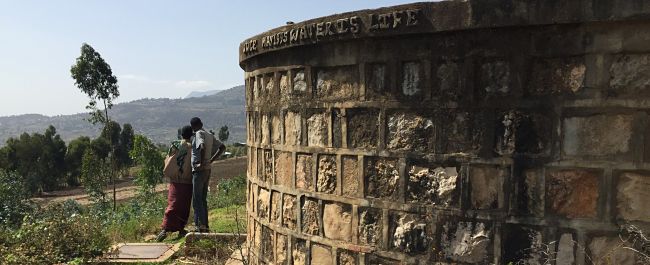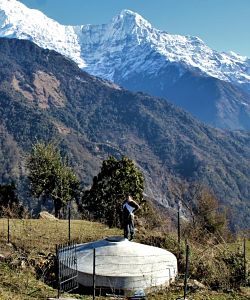
Image credit: Adrian Flint
The importance of Resilience
More frequent precipitation extremes and climate variability is occurring as a result of climate change. Floods and droughts have a significant impact on already fragile water and sanitation services leading to often devastating consequences for people living in the affected area. At the moment we don’t have simple ways to measure the resilience of these services, making it difficult to identify solutions for vulnerable communities.
Developing resilience indicators and tools to help
The How Tough is WASH? project addressed the lack of simple indicators of resilience.
We combined climate, engineering, mathematical and social science to identify the key factors that affect the resilience of water and sanitation.
We developed and tested indicators that measure whether drinking water supplies and sanitation in rural areas and small towns in Nepal and Ethiopia are resilient to the future impacts of climate change.
The indicators and tools we developed were useful because:
- They considered multiple domains of resilience
- They contained a small and manageable number of indicators
- They were developed using a storylines approach based on projections from the World Climate Research Programme climate change models. This allowed users (water and sanitation service operators) to focus on conditions that they were most likely to encounter.
- They included guidance for users on how to score the indicators and easy to use resources will be available
- They could be used in resource-limited settings
- Users were able to identify the least resilient domain(s) in their system. This meant they could decide which aspects of their systems require immediate attention and how to prioritise funding
Monitoring access to climate-resilient WASH systems and their contribution to build community resilience was critical in light of the increasing impacts of climate change on WASH systems, human health and socio-economic development. The following video brings together practitioners working on climate resilient WASH and monitoring experts to discuss a way forward.
Professor Guy Howard presenting our work on How Tough is WASH? at World Water Week in 2021. (at 33 mins)
More information on indicators
Research Outcomes and Impacts
 Image: Water storage tank in Ghandruk, Nepal, courtesy of Moti Poudel.
Image: Water storage tank in Ghandruk, Nepal, courtesy of Moti Poudel.
The resilience indicators can be used by governments, civil society and development partners to develop and maintain more resilient water and sanitation services.
To support wider uptake, we are linking to the governments and their partners in both countries to support water and sanitation policies and projects.
We also worked with the World Health Organization, Gates Foundation, UNICEF and the UK Government to support other countries to use our findings.
Resilience Indicators
Measuring resilience is challenging and encompasses an assessment of
- Infrastructure
- Environment
- Institutions
- Finance
- Behaviours
Existing work on resilience indicators specific to WASH are high-level and of limited use as operational tools. The resilience indicators we developed are simple. They covered the range of factors that may have influenced the resilience of WASH services. In this way we investigated different domains of resilience, which were linked, with failure in one aspect affecting the others.
We developed a conceptual framework for resilience of water and sanitation that considered six domains
- Infrastructure
- Catchment
- Supply chains
- Local government support
- Water and sanitation management
- Community engagement and cohesion
We developed a set of indicators, one for each domain. Each indicator could be scored from 1 to 5, 1 being the least resilient and 5 being the most resilient. Each ‘score’ is defined by a set of conditions.
The resilience indicators we designed allowed water and sanitation service providers (users) to examine how their systems and services respond to existing climate variability and extremes.
Users of the indicators could carry out a variety of assessments of their systems to identify the level of resilience that best represents their system.
Users could then prioritise funding and resources to areas of their water and sanitation systems in most urgent need of attention.

